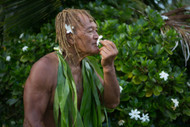Why is Tiare maori the Cook Islands' favorite flower?
Posted by Maris on 11th Oct 2023
The star-like tiare maori (Gardenia taitensis) is to Cook Islanders what edelweiss is to Austrians. Tiare maori is a metaphor used in Maori poetry and song to depict beauty or a loved one. With its soft smell, this flower has become the most adored of all flowers, symbolizing purity, passionate love, love for motherland, and a connection to the ancient place of origin, 'Avaiki (Hawaiki).
The waxy-leafed plant, a relative of the coffee plant in the Rubiaceae plant family, originated in Asia and came in the Cook Islands with the early Maori immigrants. Tiare is the generic Maori term for flower, but this is the only flower called'maori,' which meaning 'indigenous' in the Cook Islands' Maori language.

Tahitian gardenia is a misnomer because the plant is not native to Tahiti. Its Latin name was taken from specimens gathered in Tahiti in 1824 by the French explorer Dumont d'Urville.
There are many unique and colorful plants in Cook Islands gardens, but none have the elegance and simplicity - and, most importantly, a place of reverence in the Cook Islands people's hearts. All other flowering plants in those gardens predate Tiare maori.
A thick 'ei (garland) created from nearly-open tiare maori is considered the most prestigious of all 'ei, and having such garlands placed on your head and shoulders by friends or family demonstrates their deep love and respect for you. Tiare maori 'ei are traditionally offered during weddings, graduations, welcome ceremonies, and funerals. It is not uncommon to see the body of the deceased, the coffin, or the grave layered with long wreaths of garlands created from this flower at a funeral. After the birth of a female child, it is also customary in the Cook Islands to plant a tiare maori shrub on top of a 'enua (placenta) buried in the dirt.

Tiare maori is always harvested in the evenings, soon as the sun sets, because this is when the flower blooms. The flower that has been open for a day is never harvested because it is inappropriate for 'ei-making, but it can be utilized for other purposes, such as scenting coconut oil.
Once used, a tiare maori 'ei is never thrown away; instead, it is always preserved by storing it in the fridge (wrapped in a wet tea towel) or wrapping it in pawpaw leaves. Tiare maori 'ei may also be presented to folks to wear on a night out, or it may be laid on the grave of a loved one. Even after the flowers in the 'ei have faded, people would sometimes hang it in the bathroom or another part of the house for the aroma, which seems to intensify as the petals die. This is Maori strew.

Many Cook Islands Maori people plant tiare maori shrubs around their homes, and it is usual to see Cook Islanders wearing the flower as part of their everyday attire, either behind the ear or in a coronet on their heads. Men normally wear a bud behind the ear, while women wear an open blossom either behind the ear or in their hair. Not only is the blossom attractive, but the tree's buds, blooms, and leaves are used in traditional medicine, particularly to treat migraines, headaches, eczema, and sinusitis. This plant's blossom is used to perfume coconut oil, which is massaged into the skin and hair; the plant's waxy leaves are used as funnels to pour coconut oil into the bottle from which the oil is to be dispensed.
Tiare maori plants flourish best when planted alone - Maori people call it a 'jealous' plant since it does not survive when put too close to other plants. It thrives in sunny situations with loose, loamy soil along the seaside. Older plants can grow to be 4-5 meters tall.
The flower normally has 5-7 petals, but occasionally there are more, which, like the four-leafed clover, draws attention.

This plant brought with it the memories of the old Polynesian homeland, 'Ava'iki, and the family left behind for the early immigrants of the Cook Islands. The tiare maori is still a tangible link to that illustrious history today.
There were three tiare maori plants with severely gnarled trunks in Mauke, at Oneunga, until recently. Taratoa, the renowned Mauke-Atiu warrior, is claimed to have planted one around 650 years ago, and the other two were planted by his war companions: Marouna from Aitutaki and e from Mangaia. The men are claimed to have planted these trees to memorialize their friendship after fighting numerous historic battles together, such as conquering the aitu (possibly Tahitians) who had invaded Aitutaki.
A very old tiare maori tree planted by Ruatapu, an adventurer, some 800 years ago was reported to exist on Manuae, near Aitutaki.

